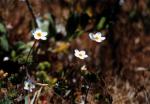Unsere Facebook-Gruppe: Heilpflanzen als Medizin
: - Linanthus parviflorus (Benth.) Greene
Englisch: Thread-flower gilia, Thread flower gilia, Variable linanthus

Synonyme :
Gilia hybrida (A.Vilm.) Brand
Gilia hybrida (Voss) Mottet
Gilia lutea Steud.
Gilia lutea subsp. eulutea Brand
Gilia lutea subsp. micrantha Brand
Gilia lutea var. longistylis Munz
Gilia lutea var. luteola Brand
Gilia lutea var. rosea (W.Thomps.) Regel
Gilia micrantha Steud.
Gilia micrantha var. aurea Benth.
Leptosiphon aureus E.Vilm.
Leptosiphon hybridus Voss
Leptosiphon luteus Benth.
Leptosiphon roseus W.Thomps.
Linanthus androsaceus subsp. croceus (Milliken) H.Mason
Linanthus androsaceus subsp. croceus (Milliken) Mason
Linanthus androsaceus subsp. laetus (Benth.) H.Mason
Linanthus androsaceus subsp. laetus (Benth.) Mason
Linanthus androsaceus subsp. luteolus (Greene) H.Mason
Linanthus androsaceus subsp. luteolus (Greene) Mason
Linanthus androsaceus subsp. luteus (Benth.) H.Mason
Linanthus androsaceus subsp. luteus (Benth.) Mason
Linanthus androsaceus subsp. micranthus (Steud. ex Benth.) H.Mason
Linanthus androsaceus subsp. micranthus (Steud. ex Benth.) Mason
Linanthus androsaceus subsp. plaskettii (Eastw.) H.Mason
Linanthus androsaceus subsp. plaskettii (Eastw.) Mason
Linanthus androsaceus var. croceus (Eastw.) Jeps.
Linanthus luteolus Greene
Linanthus parviflorus (Benth.) Greene
Linanthus parviflorus var. croceus Milliken
Linanthus parviflorus var. luteolus Milliken
Linanthus plaskettii Eastw.
Navarretia lutea (Steud.) Kuntze
2 Bild(er) für diese Pflanze
Linanthus parviflorus © Gravitywave @ USA |
Linanthus parviflorus © John Marquis @ La Crescenta, CA, United States |
Abmessungen:
Frucht Größe:
Samen Größe:
Wuchsform
 Gehölze, Bäume excl. Halbsträucher
Gehölze, Bäume excl. Halbsträucher  Krautige Pflanzen, Halbsträucher
Krautige Pflanzen, Halbsträucher Blütezeit
Pflanze Jährigkeit
Haare
 Haare drüsig, warzig
Haare drüsig, warzig  Haare Sternzellig, auch 2-armig, verzweigt oder federig
Haare Sternzellig, auch 2-armig, verzweigt oder federig  Haare verzweigt
Haare verzweigt Blätter
 Blätter gegenständig oder wirtelig (quirlig)
Blätter gegenständig oder wirtelig (quirlig)  Blätter wechselständig (exkl. Zweizeilig bei Einkeimblättriten)
Blätter wechselständig (exkl. Zweizeilig bei Einkeimblättriten)  Blätter einfach, ungeteilt
Blätter einfach, ungeteilt  Blätter mehrteilig, verzweigt, kompliziert
Blätter mehrteilig, verzweigt, kompliziert  Blätter gefiedert (4 oder mehr Blätter)
Blätter gefiedert (4 oder mehr Blätter)  Geadert, gefiedert oder kaum sichtbar in Blätter oder Teile geteilt
Geadert, gefiedert oder kaum sichtbar in Blätter oder Teile geteilt  Aderung handförmig in Blätter oder Blatteile
Aderung handförmig in Blätter oder Blatteile  Blattränder ohne Lappen, Zähne, Teile
Blattränder ohne Lappen, Zähne, Teile  Blätter oder Blatteile gelappt oder geteilt
Blätter oder Blatteile gelappt oder geteilt  Bltter oder Blatteile gezahnt, gesägt, gekerbt, usw.
Bltter oder Blatteile gezahnt, gesägt, gekerbt, usw.  Epidermid des Blattes papillös (nur Zweikeimblättrige)
Epidermid des Blattes papillös (nur Zweikeimblättrige)  Nebenblätter fehlen
Nebenblätter fehlen Blütenstand
 Blüte einzeln
Blüte einzeln  Blutenstand eine Doldentraube, einfach und monopodial
Blutenstand eine Doldentraube, einfach und monopodial  Blütenstand ein Kopf, einfach und monopodial
Blütenstand ein Kopf, einfach und monopodial Blüten
 bisexuell
bisexuell  actinomorph bzw. Sternförmig, Radialsymetrisch, Radförmig usw.
actinomorph bzw. Sternförmig, Radialsymetrisch, Radförmig usw.  zygomorph, dorsiventral oder monosymmetrisch oder unregelmässig
zygomorph, dorsiventral oder monosymmetrisch oder unregelmässig  Blütenboden klein, (oberständiger Fruchtknoten)
Blütenboden klein, (oberständiger Fruchtknoten)  Staubgefässe vorhanden (Ringförmig oder Drüsen)
Staubgefässe vorhanden (Ringförmig oder Drüsen)  Blütenhülle (Perianth) Segmente:> 6
Blütenhülle (Perianth) Segmente:> 6  Blütenhülle von Kelch und Krone
Blütenhülle von Kelch und Krone  Kelchblätter 5
Kelchblätter 5  Kelchblätter verwachsen (mindestens 2)
Kelchblätter verwachsen (mindestens 2)  Kelchblätter schuppig oder verzerrt
Kelchblätter schuppig oder verzerrt  Kelchblätter röhrig oder zusammengelegt
Kelchblätter röhrig oder zusammengelegt  Blütenblätter 5
Blütenblätter 5  Blütenblätter verwachsen (mindestens 2)
Blütenblätter verwachsen (mindestens 2)  Blütenblätter verzerrten
Blütenblätter verzerrten  Staubbeutel 5, fruchtbar
Staubbeutel 5, fruchtbar  Staubbeutel dorsal oder herzförmig fixiert
Staubbeutel dorsal oder herzförmig fixiert  Staubbeutel an der Basis fixiert
Staubbeutel an der Basis fixiert  Staubbeutel nach Innen gerichtet
Staubbeutel nach Innen gerichtet  Staubbeutel länsschlitzig öffnend
Staubbeutel länsschlitzig öffnend  Staubblätter in die Krone eingefügt
Staubblätter in die Krone eingefügt  Staubfäden nicht verwachsen
Staubfäden nicht verwachsen  Stiel 1, oder: Stiele mehr oder weniger verwachsen (Fruchtblätter frei oder verwachsen)
Stiel 1, oder: Stiele mehr oder weniger verwachsen (Fruchtblätter frei oder verwachsen)  Fruchtblätter 2 (frei oder vereinigt)
Fruchtblätter 2 (frei oder vereinigt)  Fruchtblätter 3 (frei oder vereinigt)
Fruchtblätter 3 (frei oder vereinigt)  Fruchtblätter 5 (frei oder vereinigt)
Fruchtblätter 5 (frei oder vereinigt)  Fruchknoten 2-kammerig
Fruchknoten 2-kammerig  Fruchknoten 3-kammerig
Fruchknoten 3-kammerig  1 Samen pro Fruchtkammer
1 Samen pro Fruchtkammer  2 Samen pro Fruchtkammer
2 Samen pro Fruchtkammer  Mehr als 2 Samen pro Fruchtkammer
Mehr als 2 Samen pro Fruchtkammer  Samenanlagen zentral, Fruchtblätter verwachsen
Samenanlagen zentral, Fruchtblätter verwachsen  Samenanlagen mittig befestigt, oder bauchseits, wenn Fruchtblätter frei oder 1 Fruchtblatt
Samenanlagen mittig befestigt, oder bauchseits, wenn Fruchtblätter frei oder 1 Fruchtblatt Früchte
 Frucht ist eine Kapsel (inkl. Hülse, Schote, Balgen)
Frucht ist eine Kapsel (inkl. Hülse, Schote, Balgen)  Frucht ist eine Nuss (inkl. Schließfrucht, Spaltfrucht usw.)
Frucht ist eine Nuss (inkl. Schließfrucht, Spaltfrucht usw.)  Frucht hat 2 Samen
Frucht hat 2 Samen  Frucht hat mehr als 2 Samen
Frucht hat mehr als 2 Samen  Samen mit Flügeln
Samen mit Flügeln  Keim gerade
Keim gerade  Keim gekrümmt
Keim gekrümmt  Samen ohne Nährgewebe
Samen ohne Nährgewebe  Samen mit Nährgewebe
Samen mit Nährgewebe Verbreitung
 Asien
Asien  Europa
Europa  Nordamerika
Nordamerika  Südamerika
Südamerika  Previous
Previous


